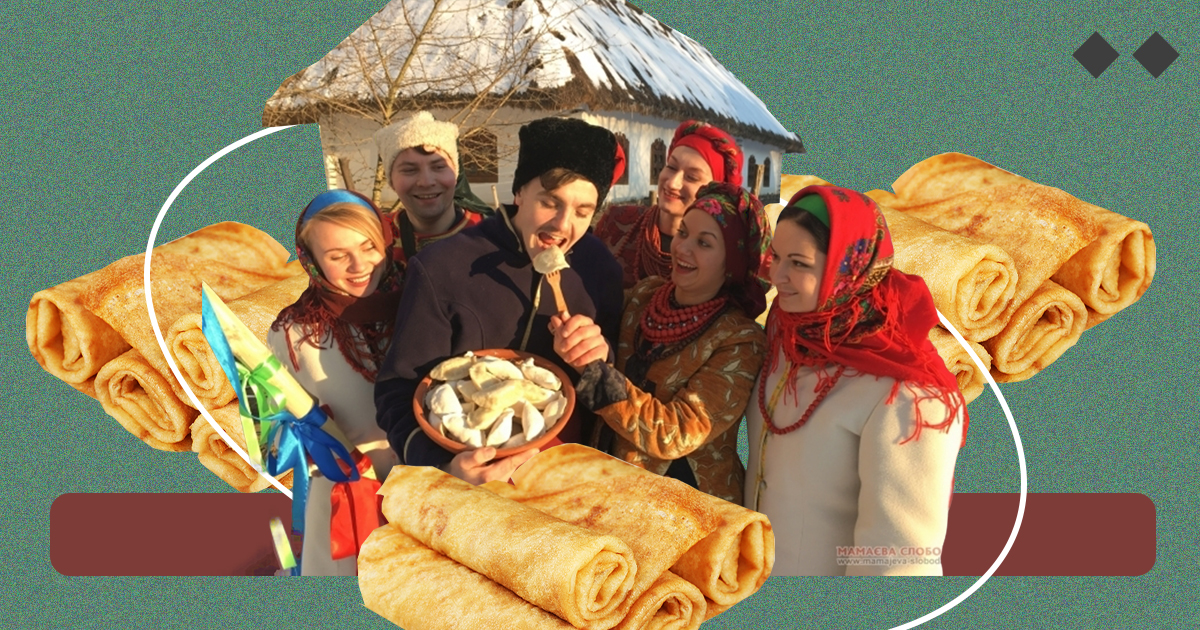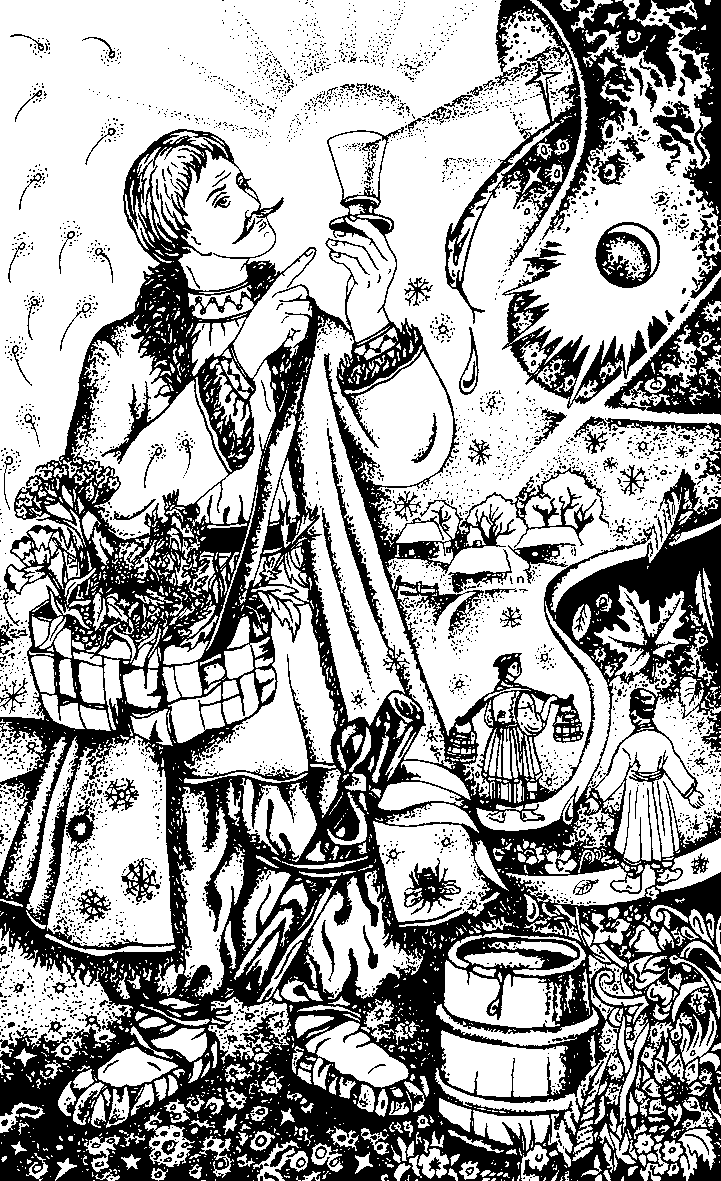Celebrate the arrival of spring with Ukraine Butter Week! Learn more about this Ukrainian spring holiday and its fun rituals.


Winter and its Christmas and New Year celebrations have come and gone, and in their place has come the hope of renewal. For centuries, Ukrainians believed a new year began with spring and its victory over deadness and darkness.
In Ukrainian folklore, spring is imagined as a young, beautiful woman in a long, pure-white dress with a flower crown on her head. Some legends say spring is a swallow that carries warmth and good fortune to the people on its wings.
To ensure spring arrived kind and generous, Ukrainians staged special rituals and sang songs to invite the season into their lives. These traditions are part of Masnytsia, also known as Butter Week or Cheeseware Week, a Ukrainian spring holiday created as an opening ceremony or festival to bewitch spring.
Rubryka will share how Masnytsia is celebrated in Ukraine — its amusing customs, songs, and delicious food.


Ukraine Butter Week: Kolodii is a pagan god of marriage honored during Masnytsia. Photo: proridne.org
Like Ukraine, many nations across Europe have their version of the holiday that honors the end of winter and the arrival of spring. You may have heard of Mardi Gras, Shrove Monday, and Shrove Sunday: they are part of the Carnival, an ancient pagan celebration that the Christian Church later adopted to mark the week before Lent. This is what Masnytsia is — the Ukrainian Carnival or Shrovetide.
The date for this Ukrainian spring holiday changes each year and depends on Easter. This year, Masnytsia falls during the week from February 24 to March 2 — seven days of bizarre rituals, which you'll find hilarious, that see winter off and welcome spring.
Ukrainians believed that the better they celebrated Masnytsia, the more generous nature would be to them when harvest time came. In Ukraine, the holiday is also known as Kolodii, named after the ancient pagan god of marriage and reconciliation. Ukrainians had rituals to honor him, and welcome health, fertility, and family harmony — marriage and babies were the highest blessings.
Ukrainian spring traditions: The Kolodka ritual begins on the first day of Masnytsia. Photo: Ladomyria
Kolodka is the most peculiar ritual preserved in most regions of Ukraine and performed to this day during Masnytsia celebrations. In the past, it was staged during the entire week. On Monday, the first day of Masnytsia, a group of married women gathered in a local tavern with a small wooden log (kolodka) and a baby-swaddling cloth. Then, they would place a log on a table, wrap it as a baby, and celebrate its "birth." Women sat around the table, poured drinks, toasted to the kolodka, and sang songs.
Throughout the week, women continued celebrating the kolodka. After it was "born" on Monday, it was "christened" the next day. On Wednesday, women hosted a feast in its honor. By Thursday, the kolodka was "dead," on Friday, it was "buried," and everyone "mourned" it by Saturday. Despite its morbid storyline, the ritual wasn't considered sad — kolodka was supposed to rise again in seven weeks at Easter, so people partied and drank with all the stops out before Lent started.
Ukraine Butter Week: Women decorated the logs with ribbons and dragged them through the village during Masnytsia. Photo: Grinchenko Inform
As part of this Ukrainian spring holiday ritual, married women also prepared small logs and decorated them with ribbons. Then, they would set off to the streets of their town or village to look for offenders — single people.
Groups of women would also visit homes with bachelors and jokingly tie a kolodka to their legs as punishment. Young men would offer some payment to the women and promise to settle down the following year. Sometimes, bachelors would run away when they saw the kolodka procession.
Ukrainian spring traditions: Kolodka was tied to unmarried men as punishment during Masnytsia. Photo: Mamaeva Sloboda Living History Museum
Unmarried women could also tie logs to young men but to their left arm. The bachelors had to "ransom" themselves with money or gifts like necklaces, ribbons, or silk scarves. In modern Ukraine, the kolodka rituals are performed for fun. They are usually compressed into one or two days during the Masnytsia celebrations hosted by open-air historical museums or cultural and art centers on the weekend. You can see the reconstruction of the entire ritual in this video here:
Ukraine Butter Week: The Kyiv Expocenter hosts Masnytsia celebrations yearly, where young women perform spring songs. Photo: @vdngkyiv/Instagram
Be it summer, autumn, winter, or spring, songs are always part of Ukrainian traditions and rituals. Like it has Christmas and New Year carols for winter celebrations, Ukraine also has special ritual songs for spring, called vesnianky.
Their name is derived from Vesna, a Ukrainian word for spring. Ukrainians traditionally started singing vesnianky as soon as they noticed the weather was warmer and the snow began melting. They sang songs during sunny days to drive away winter and urged spring to arrive faster.
During Masnytsia, spring songs were part of each ritual. Young men and women sang vesnianky during the harvest dance, in which they brought straw and threw it up in the sky to attract fertility. The songs were also performed during the Kolodka when people gathered to party and dance because they believed in the magic of their singing, which would awaken nature, speed up the arrival of warm weather, and attract a rich harvest.
The Ukrainian folktronica band Go_A, who represented Ukraine on Eurovision in 2021, made one vesnianka famous around Europe. The songwriters took the traditional Ukrainian spring song, "Spring, spring, where did you spend the winter?" as a foundation for their acclaimed track SHUM:
You can also listen to Ukrainian spring holiday songs in the modern rendition of the Ukrainian band ShchukaRyba:
Ukrainian spring traditions: Varenyky is the main Masnytsia dish. Photo: Mamaeva Sloboda Living History Museum
Since Masnytsia was more of a community celebration than a family one, people gathered for big feasts. The name "Masnytsia" comes from the word masnyi (meaning "fat" or "greasy"), so dishes had a lot of fat to nourish the body before Lent. A typical Masnytsia dinner included dishes made with cheese and butter, which is why the holiday is also known as Butter Week or Cheesefare Week.
Different regions of Ukraine had their own traditional dishes for the holiday. People enjoyed pork aspic, cheesecakes, cheese pancakes, cabbage soups, pickled cucumbers, eggs fried in butter, cottage cheese with sour cream, porridge, borshch, and milk noodles. The central dish on the Masnytsia table was — and still is — varenyky (dumplings) with cottage cheese and sour cream, a star of Ukrainian cuisine. There's even a popular saying in Ukraine: "Hold on, varenyky — Masnytsia is coming for you!"
Ukraine Butter Week: Traditional Ukrainian dumplings, varenyky with cottage cheese and sour cream. Photo: Klopotenko
During Masnytsia, people ate varenyky every day. Married women, while celebrating the "birth" of the kolodka, would dine on varenyky with cheese and butter, drink, and have fun. They also made and boiled varenyky for the community celebrations throughout the Butter Week.
There were also some amusing superstitions linked to varenyky. One claimed that to see a witch and acquire magical powers, you had to scoop out the cheese from the last dumpling on Sunday, tie it in a knot, put it in your mouth, and keep it there until morning. Some also believed that keeping the cheese in your mouth on the last day of Masnytsia would let you see not only witches but also house spirits.
While Ukrainians no longer believe in silly superstitions, they are true believers that varenyky is the best Ukrainian food you can enjoy at any point of the year. Try them and watch your life get better this spring.
Полномасштабное вторжение повлекло за собой разрушения и потери, усложнило развитие и планирование будущего. Однако экономический… Читати більше
“Рубрика” собрала для вас статьи, которые, как, собственно, и март, говорят: даже в самые сложные… Читати більше
Первым шагом к тому, чтобы распоряжаться своими средствами грамотно, является планирование бюджета. Как рассчитать средства… Читати більше
Собственным опытом и практическими советами с “Рубрикой” поделилась коррекционная педагогиня, психотерапевтка, мама детей с расстройствами… Читати більше
Вже під час війни Україна використовує штучний інтелект (ШІ) як потужний інструмент для відбудови та… Читати більше
В Житомирской областной филармонии им. С. Рихтера полгода работает студия PНIL-ART. Здесь профессиональные артисты проводят… Читати більше
Цей сайт використовує Cookies.